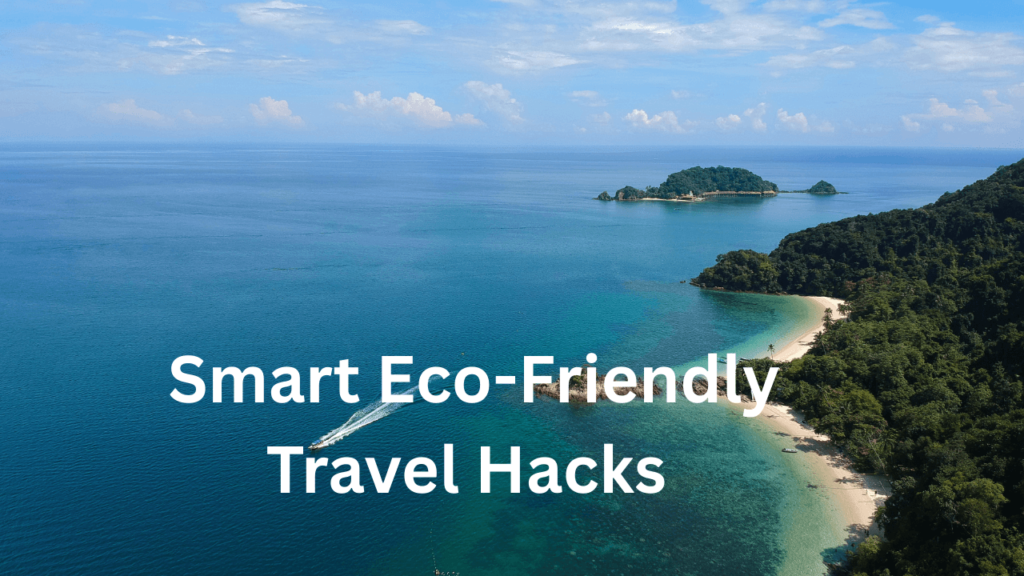Traveling is one of life’s greatest joys—it broadens our horizons, deepens our understanding of cultures, and connects us to the world in meaningful ways. But as tourism grows globally, so does its impact on the planet. According to the World Tourism Organization, tourism contributes to around 8% of global greenhouse gas emissions. From frequent flights to single-use plastics in hotels, our travel habits often leave a bigger footprint than we realize.
This is why eco-friendly travel matters more today than ever before. Being mindful of how we travel not only reduces our environmental impact but also enriches our journeys. In my own travels, I’ve found that making small adjustments—like packing reusable items or choosing local transportation—doesn’t just save resources, it also leads to more authentic, memorable experiences.
In this article, we’ll explore practical eco-friendly travel hacks that anyone can apply. Whether you’re a seasoned globetrotter, a family vacationer, or a first-time explorer, these tips will help you travel smarter, greener, and more responsibly—without compromising on fun.
Why Eco-Friendly Travel Matters Today
Tourism’s Impact on the Planet
- Carbon emissions: Air travel is one of the biggest contributors. A single round-trip transatlantic flight emits nearly the same amount of CO₂ as the average person in some countries produces in a year.
- Plastic waste: Think water bottles, single-use hotel toiletries, or take-out containers—most end up in landfills or oceans.
- Over-tourism: Popular destinations like Venice or Barcelona face strain from heavy tourist flows, leading to pollution and damage to heritage sites.
Why It’s Our Responsibility
Travel gives us the privilege of experiencing the beauty of our planet. In return, we owe it to future generations to preserve it. As the saying goes: Take only memories, leave only footprints.
Hack 1: Pack Eco-Consciously
Packing smart is one of the easiest ways to reduce your travel footprint.
- Reusable Water Bottle with Filter: Instead of buying bottled water, carry a reusable bottle. For regions where tap water isn’t safe, a filtered bottle like LifeStraw can purify water on the go.
- Eco-Friendly Toiletries: Switch to solid shampoo and conditioner bars, toothpaste tablets, and biodegradable soap. They last longer, reduce plastic waste, and save space in your bag.
- Reusable Bags: Pack a foldable tote or a few mesh produce bags for groceries or market shopping.
- Minimal Wardrobe, Maximum Use: Embrace the capsule wardrobe approach. Choose versatile, durable clothes that can be layered and mixed, reducing the need for overpacking and unnecessary shopping.
Personal note: On a trip through Southeast Asia, I carried a solid shampoo bar instead of liquid bottles—it lasted three months, saved spills in my bag, and drew curious conversations with fellow travelers.
Hack 2: Choose Greener Transportation
Transportation is where travelers make their biggest environmental impact.
- Fly Smarter: If you must fly, book nonstop flights. Takeoffs and landings burn the most fuel.
- Carbon Offsets: Many airlines now offer the option to offset emissions by investing in renewable energy or reforestation projects. While not perfect, it’s a step in the right direction.
- Trains and Buses: In Europe and Asia especially, trains are fast, affordable, and far more eco-friendly than flights.
- Walk or Cycle: Exploring cities on foot or by bike isn’t just greener—it gives you a more intimate feel for local life.
According to a 2023 European Environment Agency report, trains emit 85% less CO₂ than airplanes per passenger.
Hack 3: Stay in Eco-Friendly Accommodation
The place you stay has a big impact on your travel footprint.
- Eco-Certified Hotels: Look for certifications like Green Key or LEED, which indicate sustainable practices in energy, waste, and water usage.
- Support Small, Local Stays: Guesthouses, eco-lodges, and homestays often operate with lower environmental footprints and contribute directly to local communities.
- Check Practices: A truly eco-friendly stay will avoid single-use plastics, provide recycling bins, and use renewable energy when possible.
During a trip to Costa Rica, I stayed in an eco-lodge powered by solar energy. They collected rainwater, served local farm-to-table meals, and used composting toilets. It wasn’t just sustainable—it made me feel more connected to the environment around me.
Hack 4: Eat and Drink Sustainably
Food is one of the best parts of travel, but it can also create waste.
- Eat Local: Choosing locally grown, seasonal food reduces the carbon footprint of imported goods and supports local farmers.
- Avoid Buffets: Buffets generate significant food waste. Ordering à la carte ensures food is prepared as needed.
- Carry Reusables: A set of bamboo cutlery, a metal straw, and a reusable cup can eliminate countless single-use plastics.
- Plant-Based Choices: Even reducing meat consumption on your trip can significantly lower your footprint. Studies show that shifting to plant-based meals could reduce food-related emissions by up to 49%.
Hack 5: Be a Responsible Tourist
How we behave at destinations matters just as much as how we get there.
- Respect Local Culture and Wildlife: Don’t support attractions that exploit animals, like elephant rides or dolphin shows. Instead, visit sanctuaries or wildlife reserves that promote conservation.
- Stick to Designated Paths: Hiking or wandering off marked trails may damage fragile ecosystems.
- Mind Your Waste: If bins aren’t available, carry your trash until you find proper disposal.
- Support Local Businesses: Buy souvenirs from local artisans rather than mass-produced imports.
Example: In Ireland, I chose to buy handmade Aran knitwear from a small shop instead of cheaper, factory-produced versions. Not only was it higher quality, but the money directly supported local craftswomen.
Hack 6: Use Technology Wisely
Technology can help us travel more sustainably.
- Digital Tickets: Opt for e-boarding passes, train tickets, and museum entries instead of printing.
- Eco-Travel Apps: Apps like HappyCow help you find vegan/vegetarian restaurants, while Too Good To Go lets you buy discounted surplus food to reduce waste.
- Maps and Guides: Download maps offline instead of buying paper versions.
Hack 7: Slow Travel
One of the best eco-friendly hacks isn’t about what you pack but how you plan.
- Stay Longer: Instead of hopping between five cities in a week, choose fewer destinations and immerse yourself. This reduces transportation emissions and gives you a deeper cultural experience.
- Base Travel: Settle in one location and take day trips around it instead of long commutes.
- Seasonal Choices: Traveling in shoulder seasons reduces over-tourism pressure while still offering great experiences.
Hack 8: Offset and Give Back
Travel doesn’t just have to be less harmful—it can also be beneficial.
- Offset Programs: Beyond airline offsets, you can support verified projects like tree planting, renewable energy, or coral reef restoration.
- Voluntourism: Consider contributing a day or two to local environmental projects, like beach cleanups or community farming.
- Leave Places Better: A simple hack—pick up a few pieces of litter wherever you go. Small acts create ripple effects.
Common Questions About Eco-Friendly Travel
1. Isn’t eco-travel more expensive?
Not necessarily. Many eco-friendly habits—like packing reusables, eating local, or walking instead of taking taxis—actually save money. While eco-certified hotels can sometimes cost more, homestays and guesthouses are often affordable and sustainable.
2. What’s the single most impactful change I can make?
Flying less—or flying smarter (nonstop flights, carbon offsets)—is by far the biggest impact. But every small change adds up.
3. Do my individual choices really matter?
Yes. If millions of travelers adopt eco-friendly practices, it creates demand for systemic change in tourism, transportation, and hospitality industries.
Conclusion: A Greener Way to See the World
Eco-friendly travel isn’t about sacrificing comfort or fun—it’s about being mindful. Each choice, from the bottle you carry to the transport you take, shapes not only your travel experience but also the future of the destinations you love.
When I started adopting eco-hacks—carrying a reusable bottle, packing lighter, choosing local stays—I noticed two things: my travels became cheaper and richer in experience. I spent less time worrying about waste or logistics and more time connecting with people and places.
Travel has the power to change us—but it also has the power to harm or heal the planet. By choosing greener paths, we ensure that the breathtaking landscapes, diverse cultures, and natural wonders we cherish will still be here for future generations.
So, next time you pack your bag, ask yourself: What’s one eco-friendly hack I can apply on this trip? Small steps, multiplied by millions of travelers, can lead to big change.

Hi, I’m Tanvir, the founder and author of Explore Ireland Now. With a deep love for Ireland and its rich culture, history, and landscapes, I created this site to share everything that makes this beautiful country worth exploring. Whether you’re a local looking for hidden gems or a traveler planning your next adventure, I provide insightful guides, tips, and recommendations to help you experience Ireland to the fullest.
From stunning landscapes to vibrant cities and quaint villages, Ireland is full of wonders waiting to be discovered. Through my personal experiences and research, I aim to bring you the most up-to-date information and inspiration for your journey.
Thank you for visiting Explore Ireland Now—I hope my content helps you uncover all that this incredible country has to offer! If you have any questions or need travel advice, feel free to reach out.



